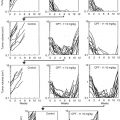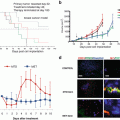The athymic “nude” mouse is possibly the most important tool in cancer research. The nude mouse has enabled the studies of human cancer in the laboratory in vivo. Nude mice were first discovered in 1962 in the laboratory of Dr. N. R. Grist at Ruchill Hospital’s Brownlee Virology laboratory in Glasgow. The nude (nu) gene behaves as an autosomal recessive. The homozygotes, nu nu, are hairless (nude). Other parts of the syndrome initially observed were sulfhydryl group deficiency and abnormal keratinization of hair follicles [1]. All major types of human cancer have been grown and characterized in nude mice.
The nude mouse was first found to be athymic by Pantelourus [2] working in Glasgow, Scotland. Jørgen Rygaard spoke with a colleague in Denmark, Dr. Kresten Work, who had seen the nude mouse in an institute in Glasgow [3]. Rygaard asked Dr. Work what is the nude mouse used for? Work replied, “Nothing….they just keep them in a cage under the lab sink” [3]. Pantelourus observed that the nude mouse was athymic. Pantelourus also observed that blood leucocytes were low in the nude mouse which meant that the nude mouse was T-cell deficient, which explains why foreign tissue is not rejected by nude mice.
Nude mice are unable to mount many types of immune responses, including antibody formation that requires CD4+ helper T cells; cell-mediated immune responses, which require CD4+ and/or CD8+ T cells; delayed-type hypersensitivity responses (require CD4+ T cells); killing of virus-infected or malignant T cells (requires CD8+ cytotoxic T cells); and graft rejection (requires both CD4+ and CD8+ T cells) [1].
Nude mouse females have underdeveloped mammary glands and are unable to effectively nurse their young; therefore, nude males are bred with heterozygous (nu/+) females. In controlled, germ-free environments using antibiotic treatment, nude mice can live almost as long as a normal mouse (18 months to 2 years) [1].
Rygaard was able to arrange a shipment of nude mice from Scotland to Copenhagen which were carried in the cockpit of the British Airways plane from Glasgow. Rygaard then bred the nude males with normal NMRI mice from Bomholtgaard and with, brother-sister mating, was producing 50–100 nude mice per week at the SPF animal facility at the Copenhagen Municipal Hospital.
Having established the nude mouse colony, Rygaard asked his colleague Carl Povlsen (1940–1986) to obtain a tumor specimen from a colon-cancer surgery. Povlsen obtained a just-excised adenocarcinoma of the colon from a 74-year-old female. Small pieces from the sterile serosal side of the specimen were implanted subcutaneously into the flank of a nude mouse and the tumor grew. Even though the original donor patient had large metastasis in the liver, the tumor grew encapsulated (noninvasively) in the nude mice, an observation that numerous researchers would make on other subcutaneously-transplanted tumors in nude mice. Only when orthotopic (literally “correct place”) models were developed were tumors able to metastasize in nude mice [3]. The nude mouse-grown tumors maintained the histology of the original patient’s tumors, passage after passage. This is one of the greatest discoveries of cancer research—a patient’s tumor could be grown and replicated indefinitely in a mouse. This discovery made human cancer research a feasible experimental science for the first time.
Rygaard donated breeding colonies of nude mice to NCI in Frederick, MD, to CIEA in Japan and to the Basel Institute for Immunology [3]. The nude mouse changed the paradigm of cancer research. Human tumors and human cancer cell lines could be grown systemically in an animal model for the first time.
Subcutaneous implantation readily allows observation of tumor take and growth. Rygaard’s and Povlsen’s patient tumor grew in all inoculated animals and reached a considerable size in the longest surviving animals. The mode of growth of the first s.c. human tumor xenograft was characteristic of what was observed later with other human patient tumors [3, 4]. The tumor was a local nodule and was encapsulated in a thin connective tissue capsule. The tumor was found to be mobile and free of the underlying fascia and covered with a network of vessels, both medium-sized and small arteries and veins. Upon histological examination, the tumor appeared to be similar to the patient’s tumor. It was a well-differentiated adenocarcinoma [3]. Tumor tissue from this first implanted tumor was serially transferred to other nude mice, again inoculated s.c. and developed in the same manner. The tumor was maintained over 7 years for 76 passages [3, 5].
In 1972, Giovanella et al. [6] successfully transplanted a human melanoma cell line into a nude mouse. Numerous human cancer cell lines have been subsequently transplanted to nude mice. A large group of human patient cancers was transplanted directly from biopsy material into nude mice by Giovanella and his team [6].
Fiebig et al. have developed a very large bank of human patient tumors transplanted directly in nude mice. Initially, Fiebig et al. transplanted 83 human colorectal and 44 stomach cancers subcutaneously in nude mice. Tumor take was observed in 78 and 68%, respectively. Progressive tumor growth was found in 49 and 32%, respectively. Serial passage was performed in 46 colorectal, 17 stomach cancers, and four esophageal cancers. Tumor stage was the most important factor for the take rate. Metastatic tumors of the colon and stomach were grown in nude mice in 89% and 54%, respectively, which was significantly higher than in non-metastatic tumors. The take rate was independent of the degree of differentiation, the amount of fibrous tissue, sex, and tumor localization. The similarity of the xenografts in serial passage in comparison to the donor tumor was shown by histological and immunological examinations. Most of the xenografts were growing more rapidly in the serial passage than in early passages. Drug treatment of the human tumors in nude mice highly correlated with clinical response for the donor patients. Predictions for resistance (100%) and sensitivity (86%) validated the nude mouse for growth of human tumors and drug sensitivity testing (see Chap. 3) [7].
The majority of human tumors were implanted in nude mice in the subcutaneous space, a site which in most cases does not correspond to the anatomical tumor localization in the patient. Discrepancies between the invading and metastasizing abilities of tumors in their natural hosts compared to those of corresponding s.c. xenografts were repeatedly described [8].
The vast majority of human solid tumors, growing as subcutaneous grafts in the nude mouse, exhibited no metastasis which is generally associated with local expansive tumor growth and the presence of circumscribed tumor borders. Wang and Sordat et al. [9] were among the first to determine whether the growth–regulatory properties of the tissue or organ site might induce changes in the expression of the invasive phenotype. Two human cancer cell lines of colonic origin, a moderately (Co112) and a poorly differentiated (Co115) carcinoma, were implanted as cell suspensions, both subcutaneously and within the descending part of the large bowel of nu/nu mice. In contrast to the well-circumscribed, pseudo-encapsulated subcutaneous tumors, Co112 and Co115 displayed a multifocal, micro- and macroinvasive growth pattern when implanted into the colon. Metastases were observed with the Co115 tumor. These were found in mesenteric lymph nodes and could be detected macroscopically. Vascular invasion by colon cancer cells was a constant finding and could be seen both for lymphatics and blood vessels. All these features, including the presence of some alterations of the microvasculature such as dilated thin-walled vessels described in human colorectal tumors, made the histopathology of these xenografts quite similar to the one reported for the original patient tumors. This seminal study indicated that tumor implantation at the orthotopic site, or site corresponding to the origin of the tumor in the patient, allows the tumor to behave in a similar manner as it did in the patient (see Chap. 4).
Stay updated, free articles. Join our Telegram channel

Full access? Get Clinical Tree





